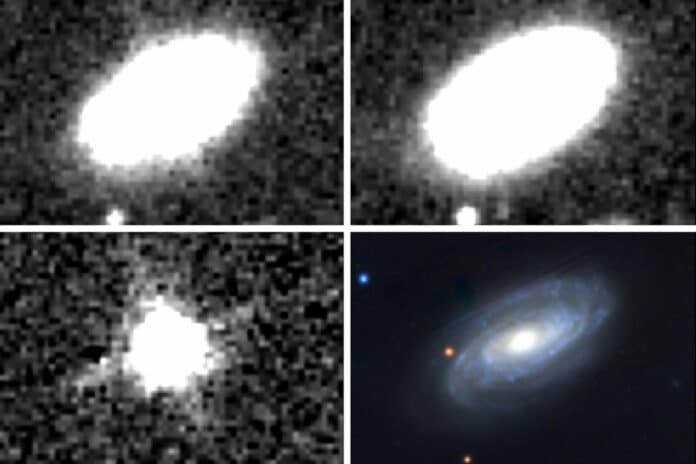While the vast majority of tidal disruption events (TDEs) have been identified by wide-field sky surveys in the optical and X-ray bands, recent studies indicate that a considerable fraction of TDEs may be dust obscured and, thus preferentially detected in the infrared (IR) wave bands.
A new study presents MIT‘s discovery of a recent tidal disruption event, shining brightly in infrared. It is one of the first times scientists have directly identified a TDE at infrared wavelengths.
To the astronomer’s surprise, the event was found to be the closest TDE observed to date. Astronomers identified the flare in NGC 7392, a galaxy about 137 million light-years from Earth. The flare, dubbed WTP14adbjsh, did not stand out in standard X-ray and optical data.
According to scientists, traditional surveys missed the nearby TDE because that light was obscured by an enormous amount of dust that absorbed the radiation and gave off heat in the form of infrared energy.
Christos Panagiotou, a postdoc at MIT’s Kavli Institute for Astrophysics and Space Research, said, “Finding this nearby TDE means that, statistically, there must be a large population of these events traditional methods were blind to. So, we should try to find these in infrared if we want a complete picture of black holes and their host galaxies.”
The team used De’s method to look for potential transient events in archival data taken by NASA’s NEOWISE mission. They discovered a bright flash that appeared in the sky near the end of 2014.
There was nothing at first. The source got brighter in 2014, and in 2015, it displayed a high luminosity, then started returning to its previous quiescence. After working through many hypotheses regarding the burst, the scientists could finally rule out all except one: the flash was most likely a TDE, and it was the closest one so far observed.
From there, the researchers looked closer at the galaxy where the TDE arose. They gathered data from multiple ground- and space-based telescopes across various wavelengths, including infrared, optical, and X-ray bands. The scientists calculated the supermassive black hole at the galaxy’s core to be around 30 million times as big as the sun based on the accumulated data.
Panagiotou said, “This is almost 10 times larger than the black hole we have at our galactic center, so it’s quite massive, though black holes can get up to 10 billion solar masses.”
The team also discovered that the galaxy is actively producing new stars.
Suvi Gezari, associate astronomer and chair of the science staff at the Space Telescope Science Institute in Maryland, who was not involved in the study, said, “The fact that optical and X-ray surveys missed this luminous TDE in our backyard is very illuminating and demonstrates that these surveys are only giving us a partial census of the total population of TDEs.”
“Using infrared surveys to catch the dust echo of obscured TDEs … has already shown us that there is a population of TDEs in dusty, star-forming galaxies that we have been missing.”
Journal Reference:
- Christos Panagiotou, Kishalay De, et al. A Luminous Dust-obscured Tidal Disruption Event Candidate in a Star-forming Galaxy at 42 Mpc. The Astrophysical Journal Letters. DOI 10.3847/2041-8213/acc02f
